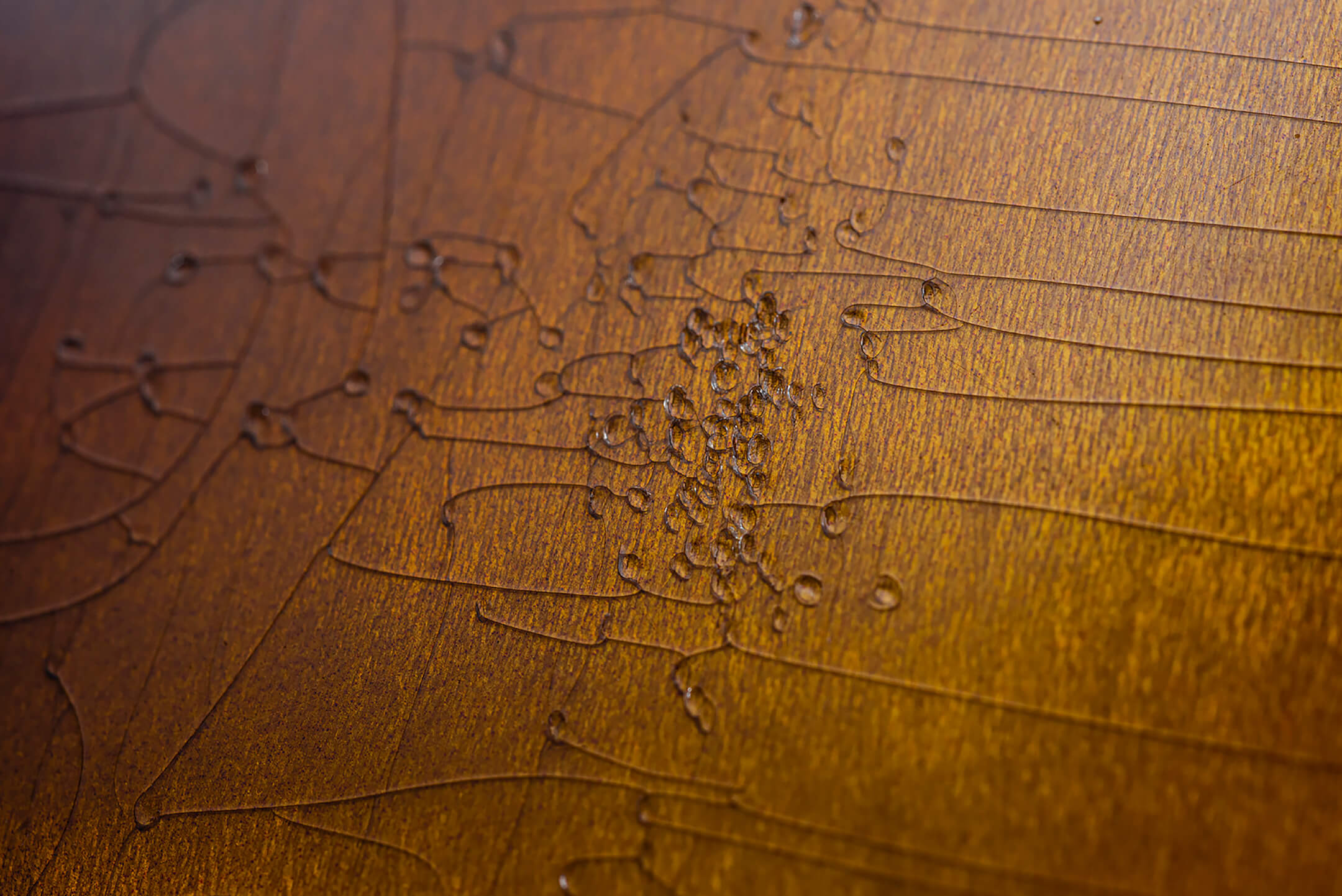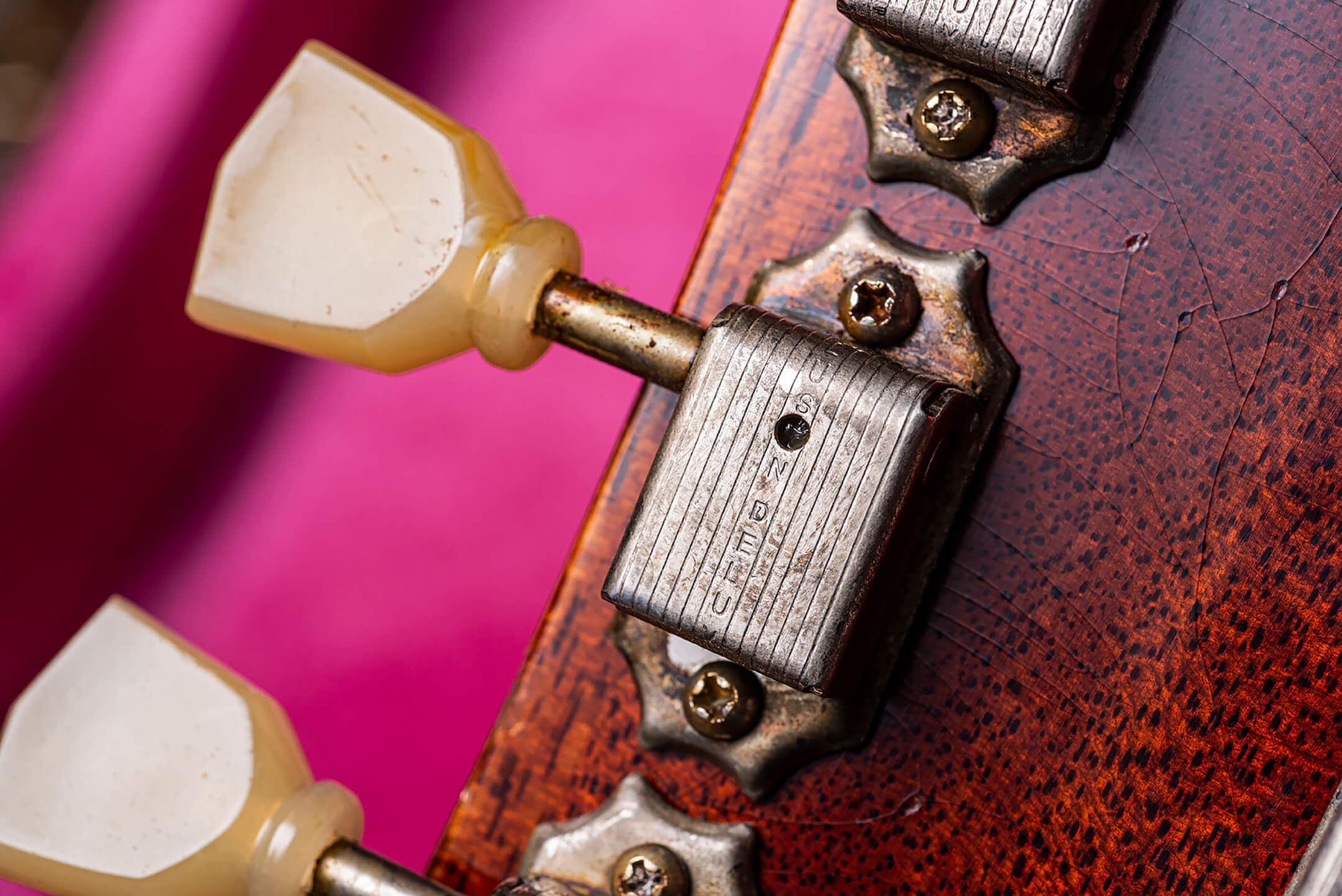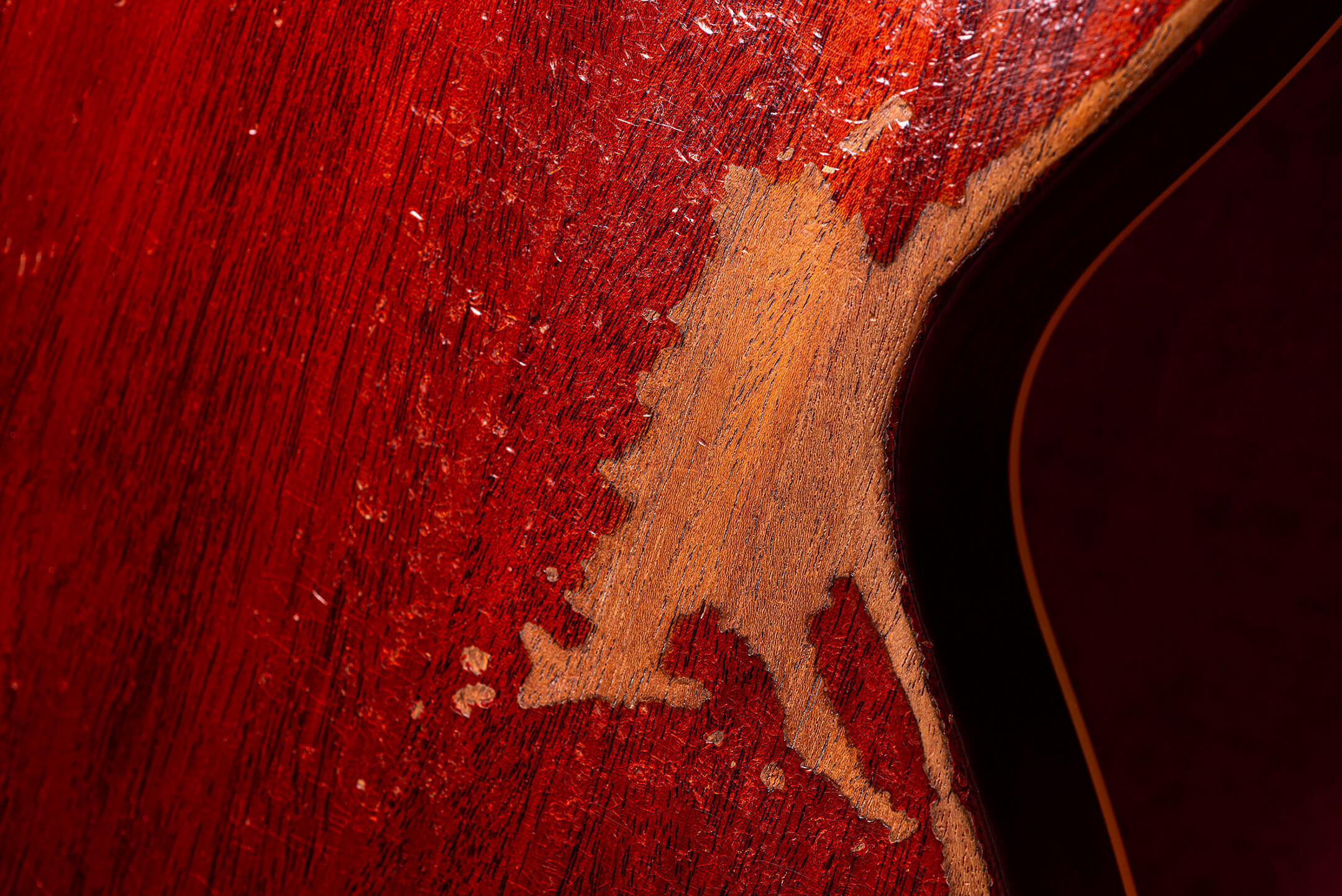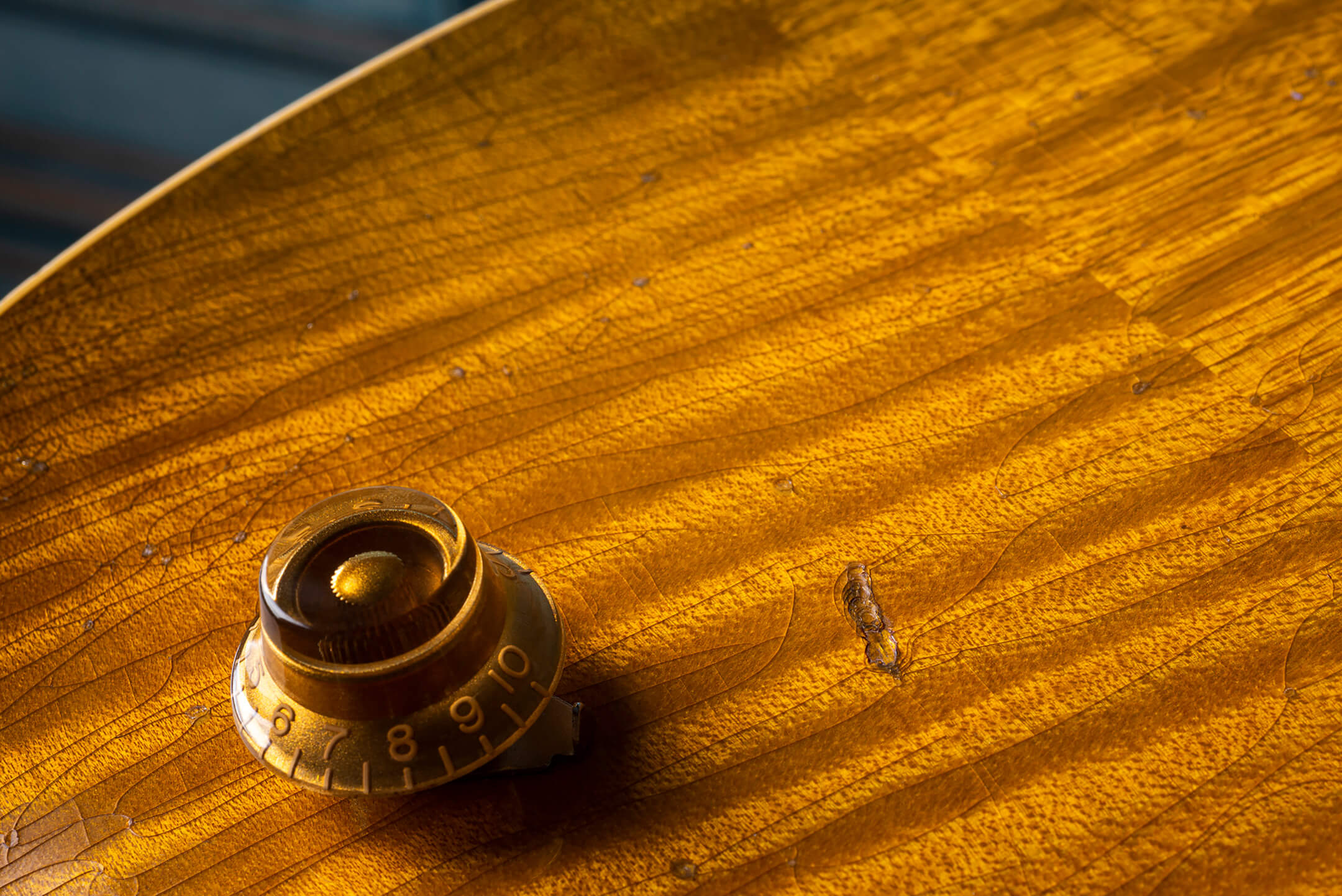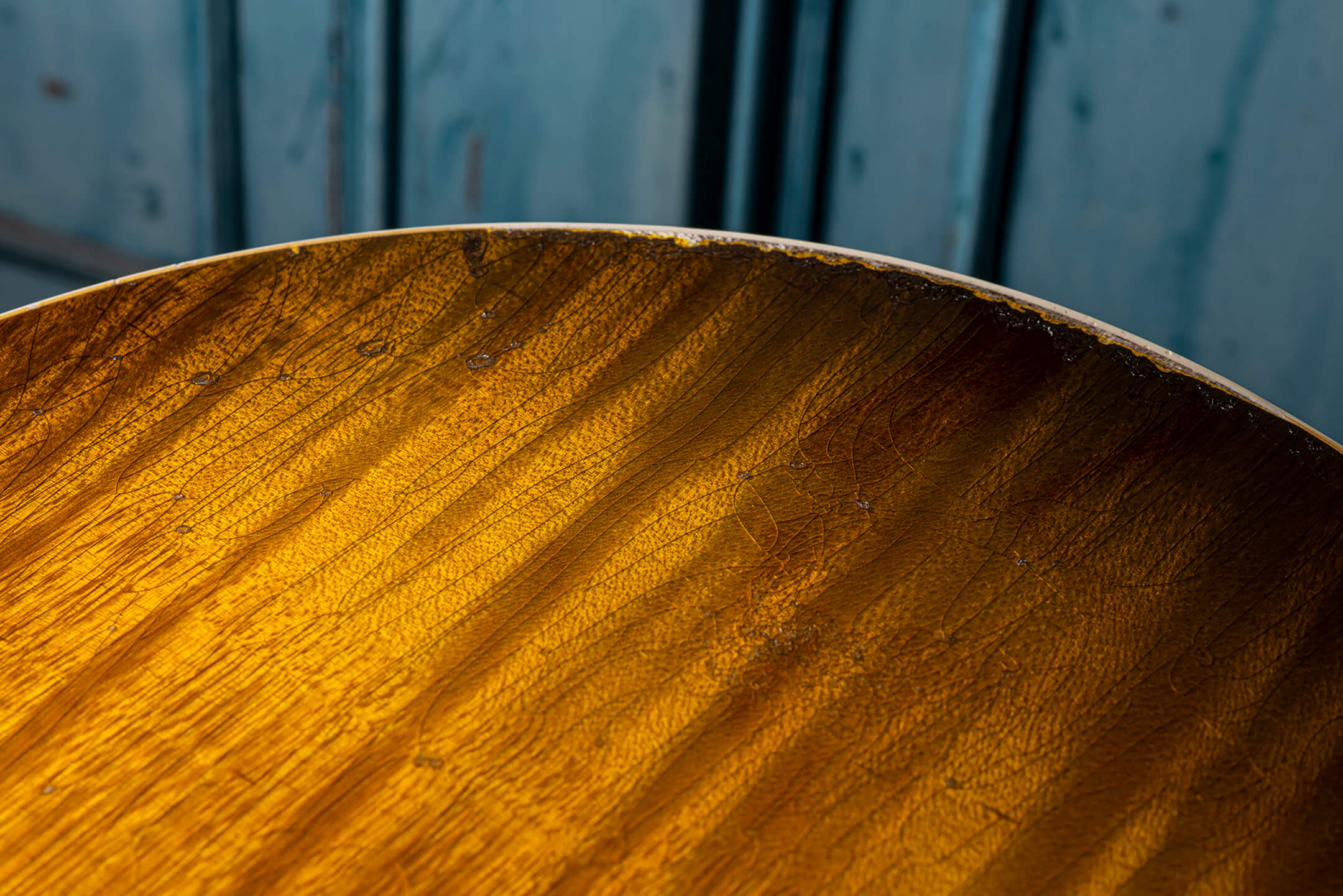Related Tags
The Big Review: Are Gibson’s Murphy Lab Les Pauls as good as it gets?
Gibson fans have waited decades for the company to make vintage-accurate Les Pauls with no caveats, compromises or corners cut. Will their patience be rewarded by the new Murphy Lab models?
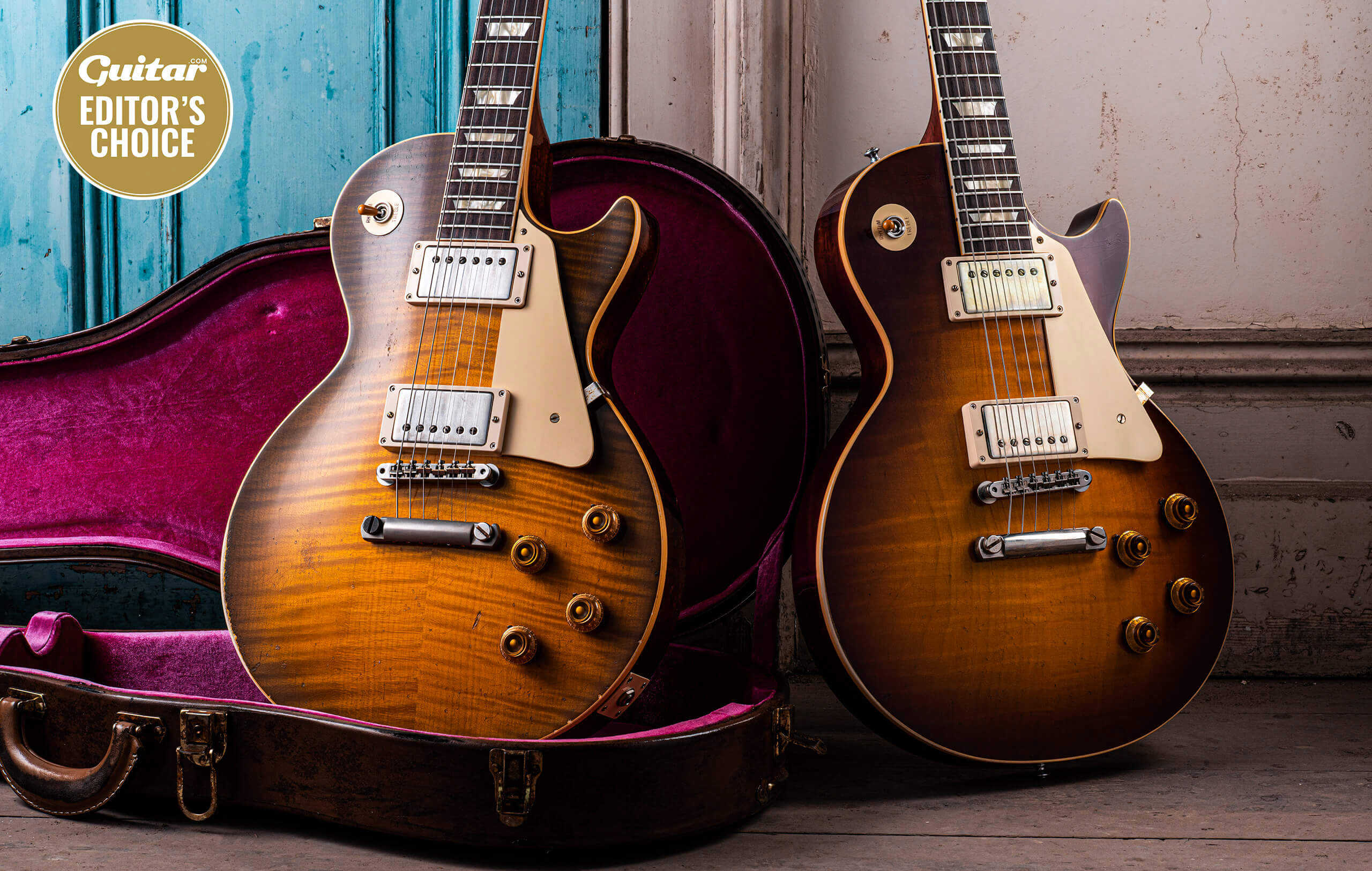
Images: Eleanor Jane
Review Overview
Our rating
9
Our verdict
If you’re unfamiliar with Tom Murphy, here’s a brief primer. He was instrumental in the development of Gibson Custom’s original Historic Les Paul models that came out in 1993 but he left the company in 1994 to establish his own small shop, Guitar Preservation. It was here that Murphy pioneered many guitar finishing and ageing techniques.
Gibson first got into factory-aged guitars in 1999 after seeing Tom’s work, and the subsequent Tom Murphy Aged instruments he worked on for the Nashville brand were regarded by most players as Gibson Custom’s top-of-the-line models. Now Gibson has established a specialist guitar-ageing department within the Custom Shop known as the Murphy Lab, along with a 50-strong collection of Murphy Lab guitars that are claimed to offer a significant step up from previous Gibson Custom ranges such as Collector’s Choice.
Gibson’s senior director of product development, Mat Koehler, explains how this came about. “The Collector’s Choice line was dropped in 2017 because it wasn’t exciting any more,” says Koehler. “Without wishing to disparage any of our collaborators, we were just copying rich people’s un-special Bursts. I didn’t like how one-note it was getting, and I wanted to make it more diverse and not be tied up in contracts. We started out by asking what we could do to provide an authentic vintage ownership experience.”
if you’ve always dreamed of owning a vintage Les Paul replica that looks and feels like the real thing, the wait could be over
“I moved back to the Nashville area about five years ago”, Murphy recalls, taking up the narrative. “I was still doing occasional finishing work for Gibson, but [brand president] Cesar Gueikian needed me full-time to fulfil their back orders for Murphy Aged guitars. I had developed this new ageing process and when I showed him my guitar, I told him that’s what the future of ageing guitars at Gibson should be. I consider the new process a major upgrade and the timing was just perfect.”
“We both thought it was a real vintage guitar,” Mat assures us. “Tom put us right and revealed it was one of his. We were attempting to age guitars in-house but I think we all knew the results were simply better when Tom did it.”
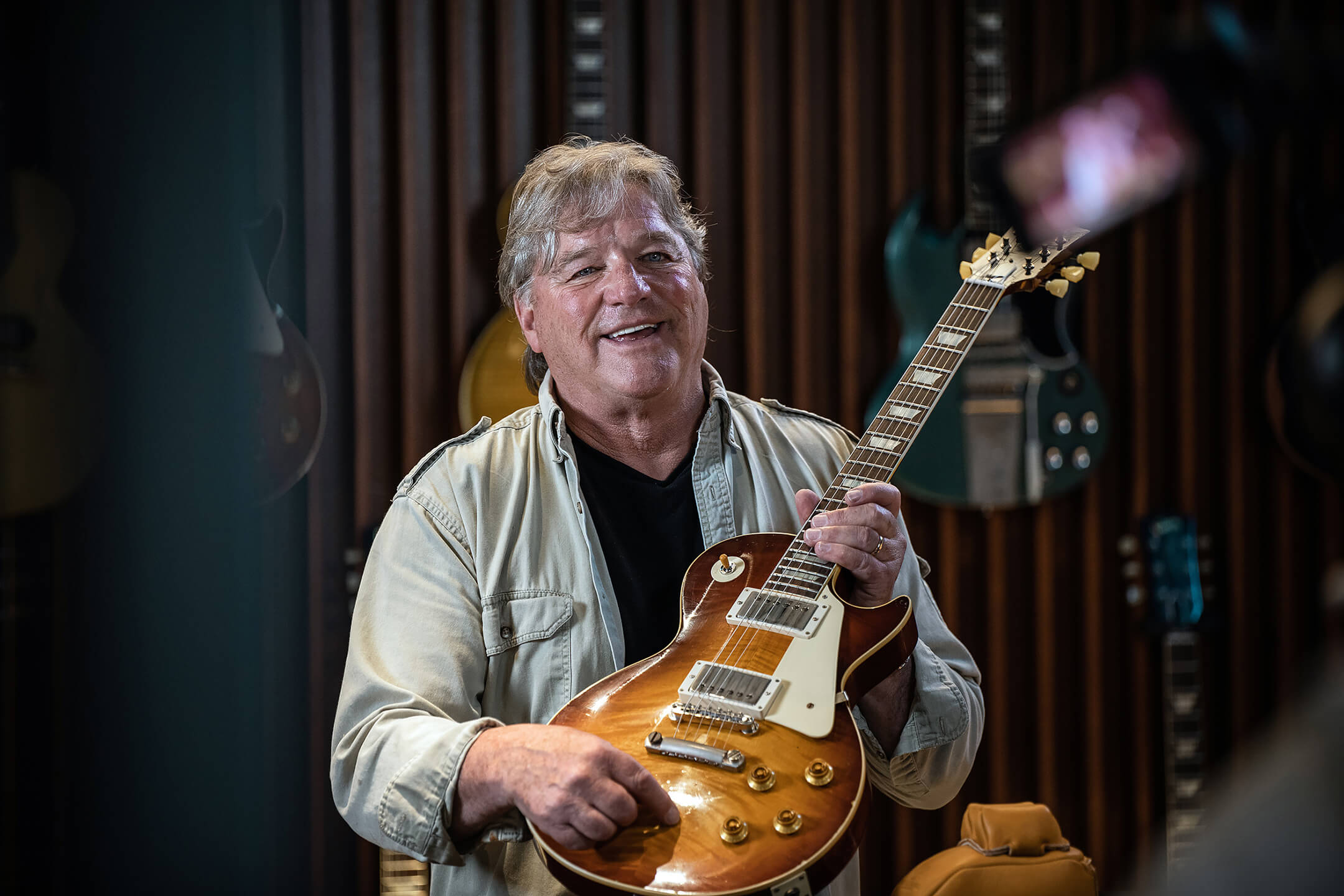
Training ground
Gueikian came up with the Murphy Lab concept, the idea being that Murphy would lead a team of people and train them to use his ageing techniques. “Before you had Murphy Aged guitars, with me doing all the ageing work, and you had the in-house versions being done in the Custom Shop,” Tom explains. “When I came back to Gibson, it was decided that all the ageing should have my name associated with it.
“There are at least two elements to these products – checking and ageing – and they’re entirely separate things. Achieving a vintage and worn look is a craft and that’s teachable. I had this new process, so the existing staff needed to be shown how to adjust their techniques, processes and tools. The phrase ‘But they always told us…’ came up a few times. I’d always say, ‘They aren’t here anymore, it’s just me, but ride along guys and it’ll be fine’.
“We had to establish some consistency and the guys have been great. When people ask who is doing the ageing, the answer is that we all are and we’re doing it my way. The beauty of this is that I no longer have to put my initials on individual guitars because my signature is on the entire operation.”
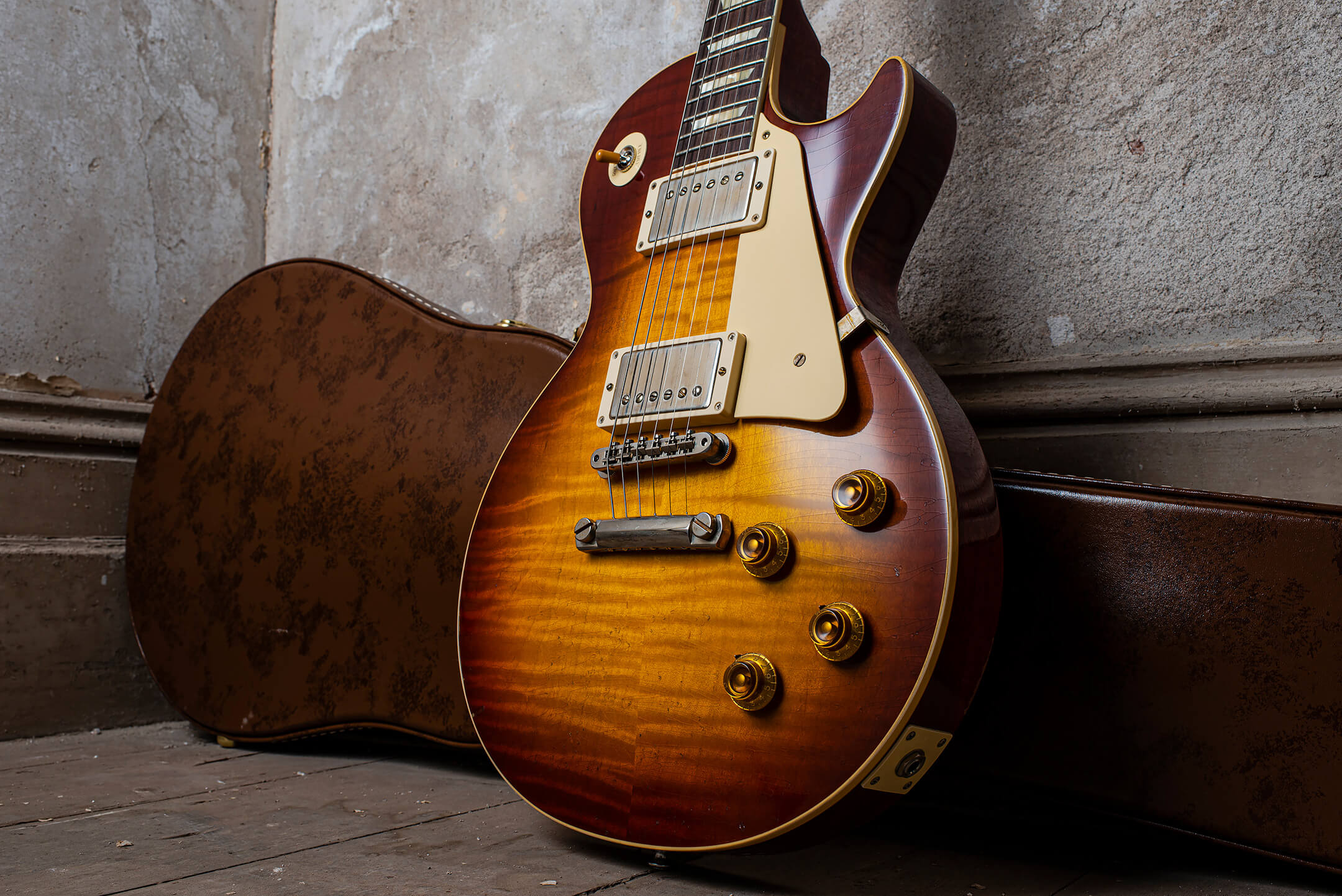
Level playing field
“It was up to Tom and me to decide on the specific characteristics and how many levels of ageing we should have”, Koehler reveals. “We added to the Custom Shop product line tremendously, with 50 new core items, while keeping it open to Made 2 Measure [Murphy Lab ageing is available on custom-ordered M2M guitars as well as in the Murphy Lab Collection – Ed]. Murphy Lab allows us to create super vibey, authentic instruments at that same level of detail as the Collector’s Choice models, but they’re more unique and have more soul.
Watch our demo of the Gibson Murphy Lab Les Pauls here:
Murphy Lab ageing options are spread across four levels. Ultra Light is described as “a prized possession that has spent most of its long life stored carefully in its case,” with minimal lacquer checking and VOS patina hardware. Light ageing adds “more intense lacquer checking patterns, accompanied by minor dings, pick trails, finish flaking, and softened edges throughout.”
Heavy ageing is designed to simulate the look of a guitar that has been “out on the road for decades” with “significant wear and tear, lots of buckle rash, light arm wear, neck wear, peghead face wear, and prominent checking patterns throughout.” The hardware is aged by the Murphy Lab.
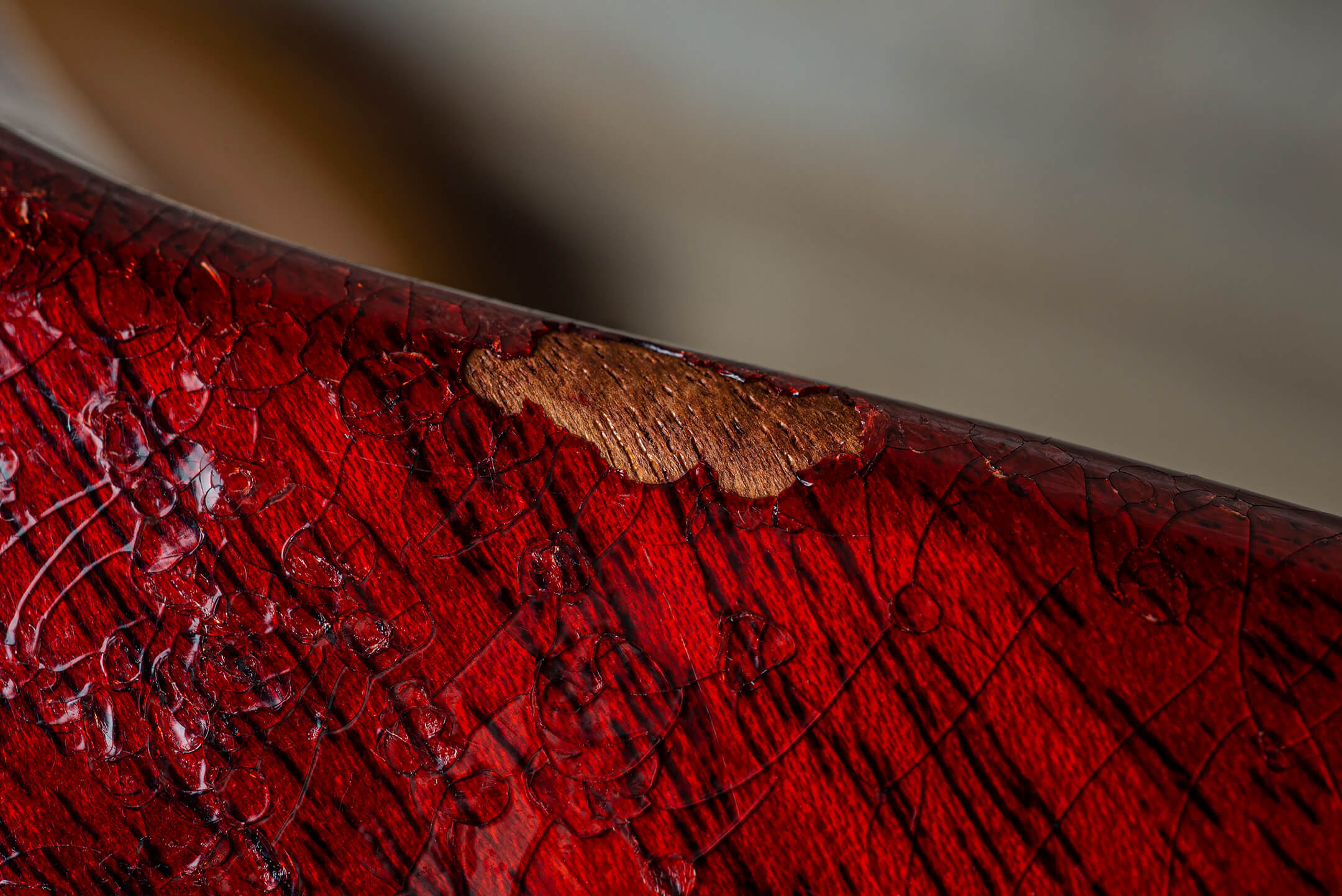
Finally, there’s Ultra Heavy, designed to evoke “half a century of touring mileage,” with “major buckle rash, heavy arm wear, visible pick, neck, and peghead face wear, and areas of exposed wood.” Additionally, all four levels feature hand-rolled fingerboard edges.
If you want the ultimate? “There is an option on the Murphy Lab price list for Tom to spray your guitar,” Mat reveals. “He’s only doing sunburst finishes and it’s got to be a standard sort of sunburst. The ageing is done by Tom and his team, and he’s especially picky about the Heavy and Ultra Heavy Aged models.”
We are interested to learn if the Murphy Lab colours are lightfast, or if owners should be aware that their guitars might fade further. Mat tells us that aniline dye is “a pain in the butt”, and although the Murphy Lab is using it for SGs and Les Paul backs, a different type of red dye is used for sunbursts. It will fade eventually, but not as fast or as far as traditional aniline. It’s reassuring because, if you choose a Murphy Lab Les Paul on the basis of colour, you can be confident that it will stay that way for many years.
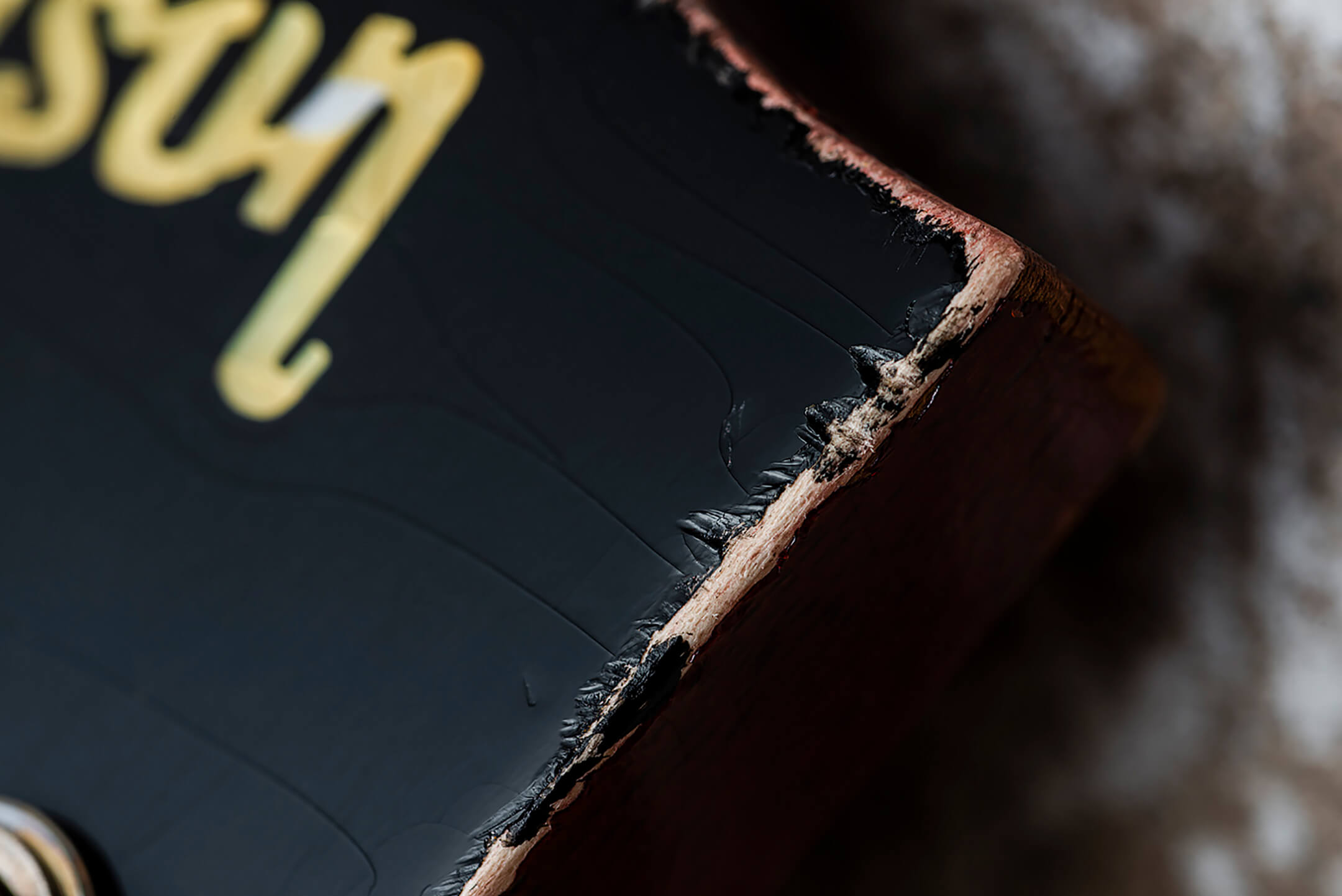
Cracking code
Tom Murphy’s reputation with a blade notwithstanding, in something of a shift for Gibson Custom, the lacquer checking on Murphy Lab models appears to be thermal rather than surgical in origin. Mat provides some clues.
“We’re using a proprietary lacquer formula,” says Koehler. “1950s and 1960s lacquer was reverse-engineered so it could be recreated in its original brittleness. Without going too deep into trade secrets, I can say that it’s not just the lacquer that’s at work. Tom’s still using his bag of tricks, so occasionally he’ll pull out a blade, but the checking itself is established by the lacquer formula.”
ageing guitars to this standard demands a lot of time and considerable skill, and that inevitably adds to the unit price
“That’s exactly right,” Tom confirms. “We all know the trademark of a vintage guitar is cracked lacquer, and that comes from expansion and contraction of the wood. I did that artificially for years, with some success, but what we have now is real. We have an old finish on a new guitar – it’s as simple as that.
“Like an old finish, it isn’t very durable. It’s not for everybody but it is awesome for ageing. Not only does it enhance the checking, when we’re chipping it to create buckle rash it responds like an old finish. When I first saw it happen I was really excited, and I still am today. So, I don’t have to do art any more, I can now do craft.”
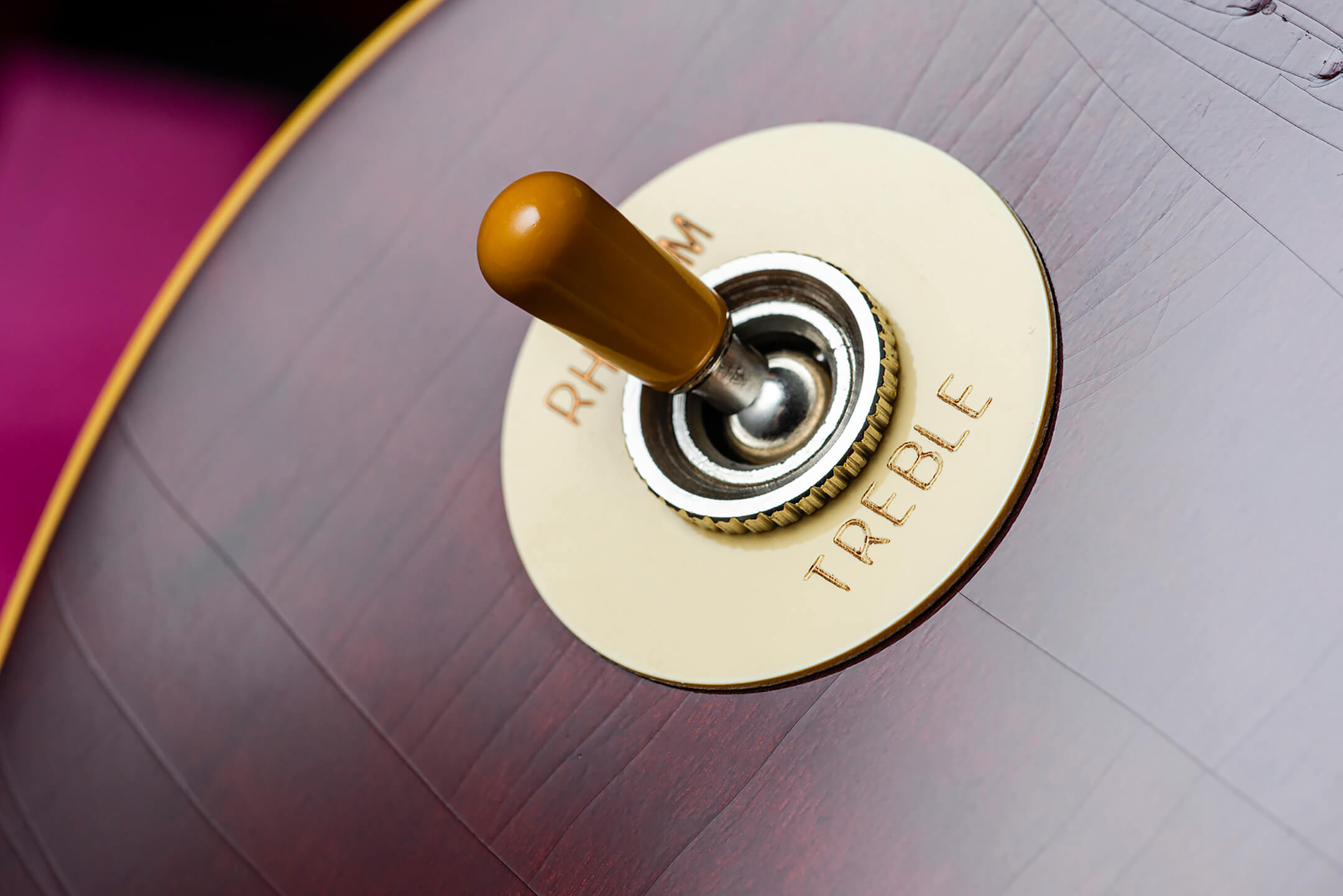
Wood work
If you are wondering whether guitars are specially produced or hand-selected for Murphy Lab treatment, Mat’s answer may come as a surprise. “The guitars themselves are basically just Historic reissues”, he reveals, “so every guitar in our Murphy Lab collection is the same as our regular ’59 Standard, with hide-glue neck and body joints. The only thing that’s going to differ is the lacquer and level of ageing. The neck profile hasn’t changed from the 2019 models.
“I didn’t want a random neck profile or some sort of average of all. I wanted to use a specific neck profile that’s very comfortable. The profile we selected was scanned from an original ’59. It’s a pretty well-known Burst and a particular favourite of mine and various artists. It’s a little bit thinner than a lot of people are expecting, because the Custom Shop made a lot of baseball bat necks with fat shoulders.
“Having been lucky enough to handle many ’59s, what I’m looking for is more of a V feel with very soft shoulders. And then the neck roll really hammers it home. But we make a distinction for the different years, so for 1958 and earlier reissues we’re using a fatter profile, and we’re using smaller frets now where appropriate.”

Historic hardware
The Murphy Lab ages bridges and tailpieces to match the heavier levels of lacquer ageing. The hardware itself comes from Gibson’s regular production line. “We do our best interpretation currently for the bridge, and the stopbar is aluminium,” Mat tells us. “We are actively working to improve the broken-in look and feel of the metal parts.
“People often ask why we withhold things, but it’s not like that. It’s really a function of how much engineering time we can dedicate to any one project, and finding a good time to integrate new parts. The most recent example is thinner thumbwheels. There’s a lot that goes on for each of those changes and our experience is that when we try to introduce too many changes at once, it’s like a butterfly effect that causes problems elsewhere.
“Manufacturability is a drawback, due to supply chain and modern compliance restrictions. Even nickel right now is hanging by a thread in terms of availability. We may know what it is we want to achieve but we often have to compromise on some minor details.”
Offering a tantalising glimpse into the future, Tom adds, “We have a new process that’s about to come online that will allow us to achieve results that are so realistic.”
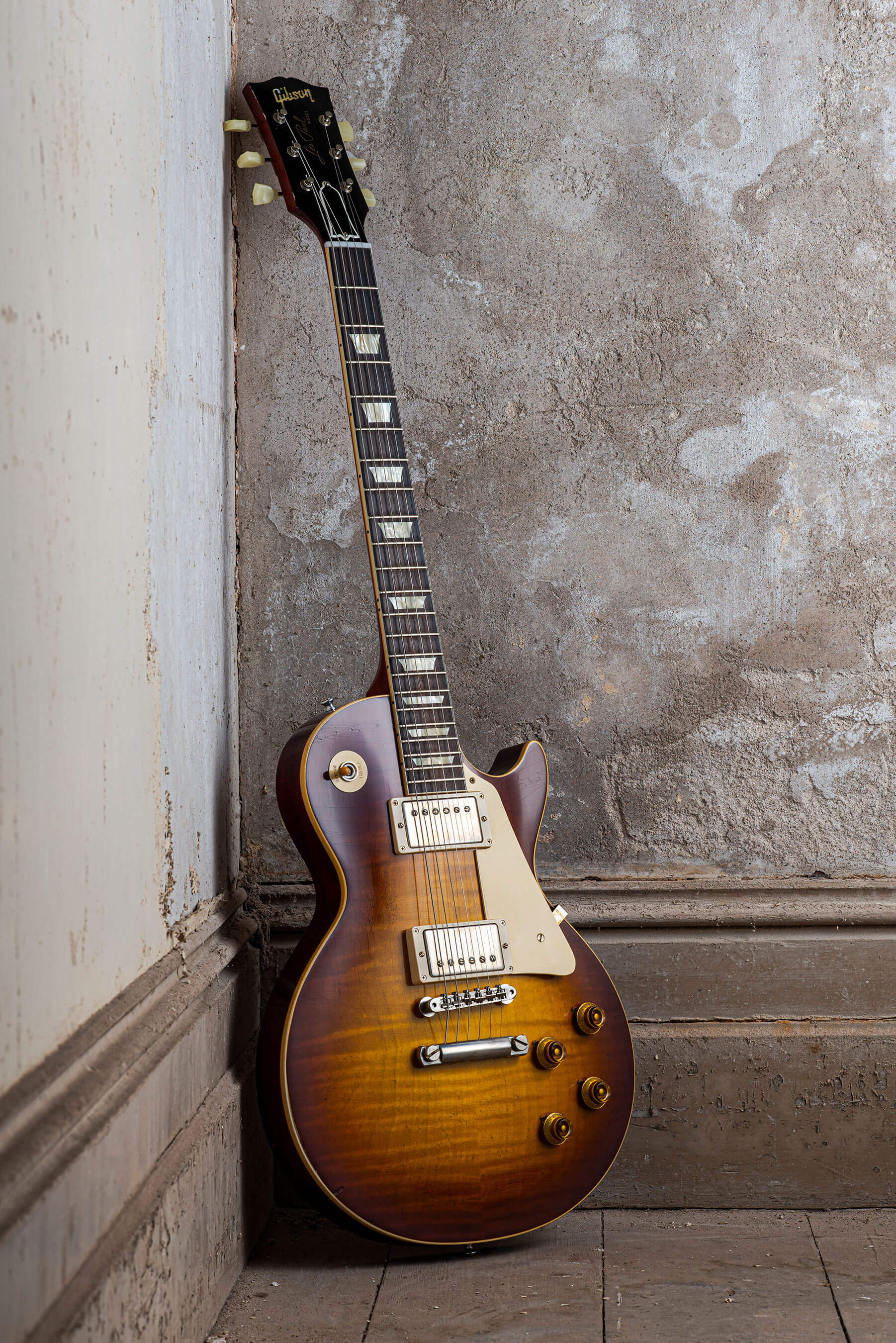
Plastics fantastic?
The Murphy Lab plastics are a legacy of the True Historic range introduced in 2015 and, although they look really good in terms of colour and are vintage-correct when it comes to materials and manufacturing methods, no attempt has been made to age them. It’s a little incongruous considering the obvious care and craft that has gone into the finishing and ageing elsewhere, and it’s something Mat is willing to acknowledge.
“When it comes to plastics, I don’t feel it’s something that Tom or anybody on his team can do that well right now”, he admits, candidly. “We went down the rabbit hole recreating the chemical compounds but, to me personally, I don’t care what the plastic parts are made from because if they don’t look original, I’m not a fan.
“At the moment we’re involved in re-scanning vintage parts from Gibson’s own collection, so we’re committed to improving that. But given our supply chain at the moment, and our level of acumen at the Custom Shop about how plastics age, the best we can do right now is provide customers with chemically recreated parts and leave the ageing for some future incorporation.”
Electronic sound
The controls and components also pre-date the Murphy Lab, having undergone a revamp in 2019. Paper-in-oil Bumble Bee tone capacitors combine with potentiometers that were reverse-engineered from 1950s pots to recreate the original taper. According to Mat, Gibson even briefly considered resurrecting the Centralab brand. Murphy Lab Les Pauls feature Custom Buckers with Alnico III magnets, which Gibson finally stopped wax-potting in 2019. The specs are not entirely vintage correct but Mat has his own take on that.
“I believe that those original pickups aged, so I’m happy with our current Custom Buckers because to me they sound like a new Les Paul would have sounded. George Gruhn and I have a running argument about this because he doesn’t believe electronics age. But right now, we’re happy with the Custom Buckers.”
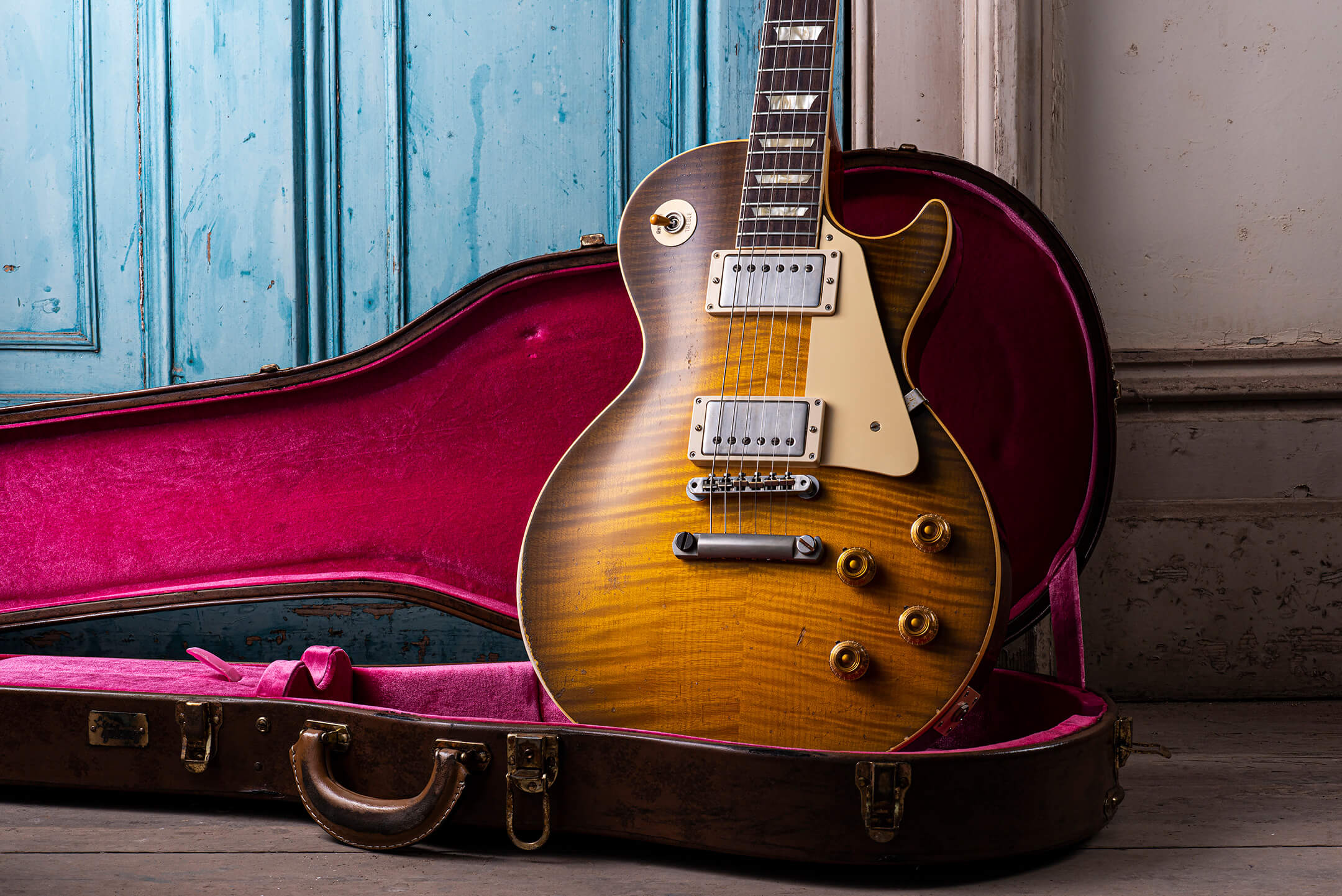
Up close
It’s time to get to grips with our review guitars and the brown five-latch cases offer a very encouraging start – one has even been aged and when opened, it could be our imagination but there does seem to be a pleasantly ‘old’ aroma. We’ve been sent two 1959 Les Paul Standards from the middle of the range – a Light Aged example in Cherry Tea Burst and a Heavy Aged Green Lemon Fade. Both have bookmatched maple tops with gorgeous figuring that isn’t too intense, and very attractive Fijian mahogany bodies.
The only differences between these guitars are the colours and levels of ageing, so all the features are shared. Highlights we haven’t already mentioned include Royalite body binding, celluloid inlays and period-correct nylon nuts. We like the vintage-style single line, single ring Kluson tuners too, although we recognise that they won’t be everybody’s first choice.
Clearly the aged finishes are the main event and here there’s some difference. The Cherry Tea Burst model’s back is a strong red, with checking that covers the body and runs all along the neck and headstock. There’s no buckle rash and the finish has only been chipped away in a couple of strategic spots.
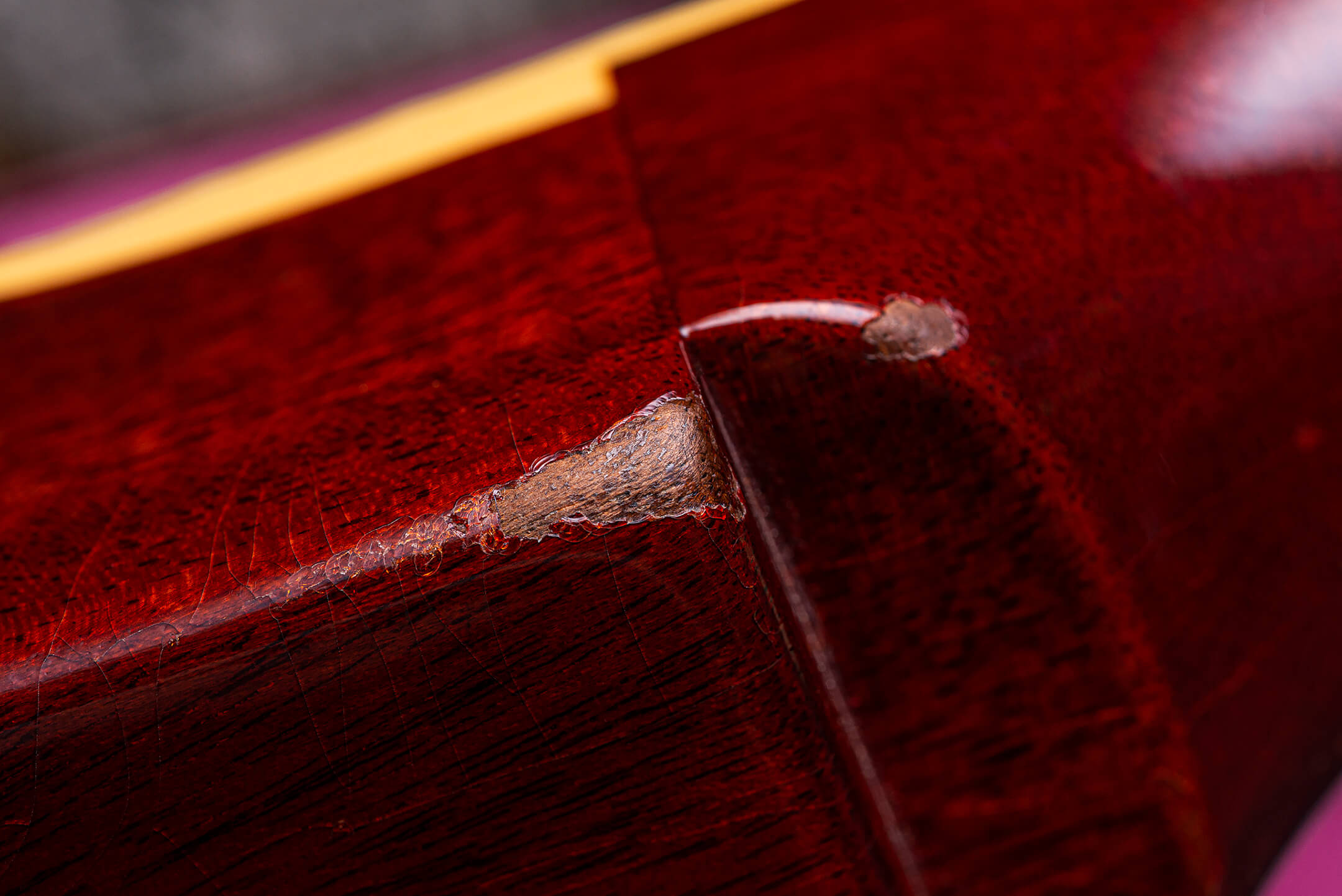
The top has countless micro dents that have allowed the lacquer checking lines to form around them in an entirely natural way. There’s chipping around the front edges of the headstock and the lacquer appears to be extremely thin. The finish has also shrunk into the grain and the slightly dulled gloss looks very convincing. The colour is a matter of taste but the yellow centre almost perfectly matches this writer’s 1956 ES-225.
The Heavy Aged Green Lemon Fade represents quite a jump in the level of distress. Heavy relic’ing can veer into unconvincing excess, but what the Murphy Lab has pulled off here is a triumph. The back is a far richer shade of dark cherry and the hint of green in the top is superbly judged. Buckle rash and neck wear are added, along with far greater forearm wear and a handful of more serious dents.
The dents are more numerous and varied in size, and the lacquer checking is extensive. And yet, compared to a Collector’s Choice model we’ve sourced for comparison, the Murphy Lab’s checking feels smooth and the overall effect makes the Custom Shop’s earlier attempts at ageing look rather lacklustre and poorly conceived.
Our only criticism is that in areas with extensive ageing, it’s apparent that the vast majority of dents have been induced using a single tool. The shape and orientation of the damage spots is a bit too uniform, but it’s only apparent under very close scrutiny.
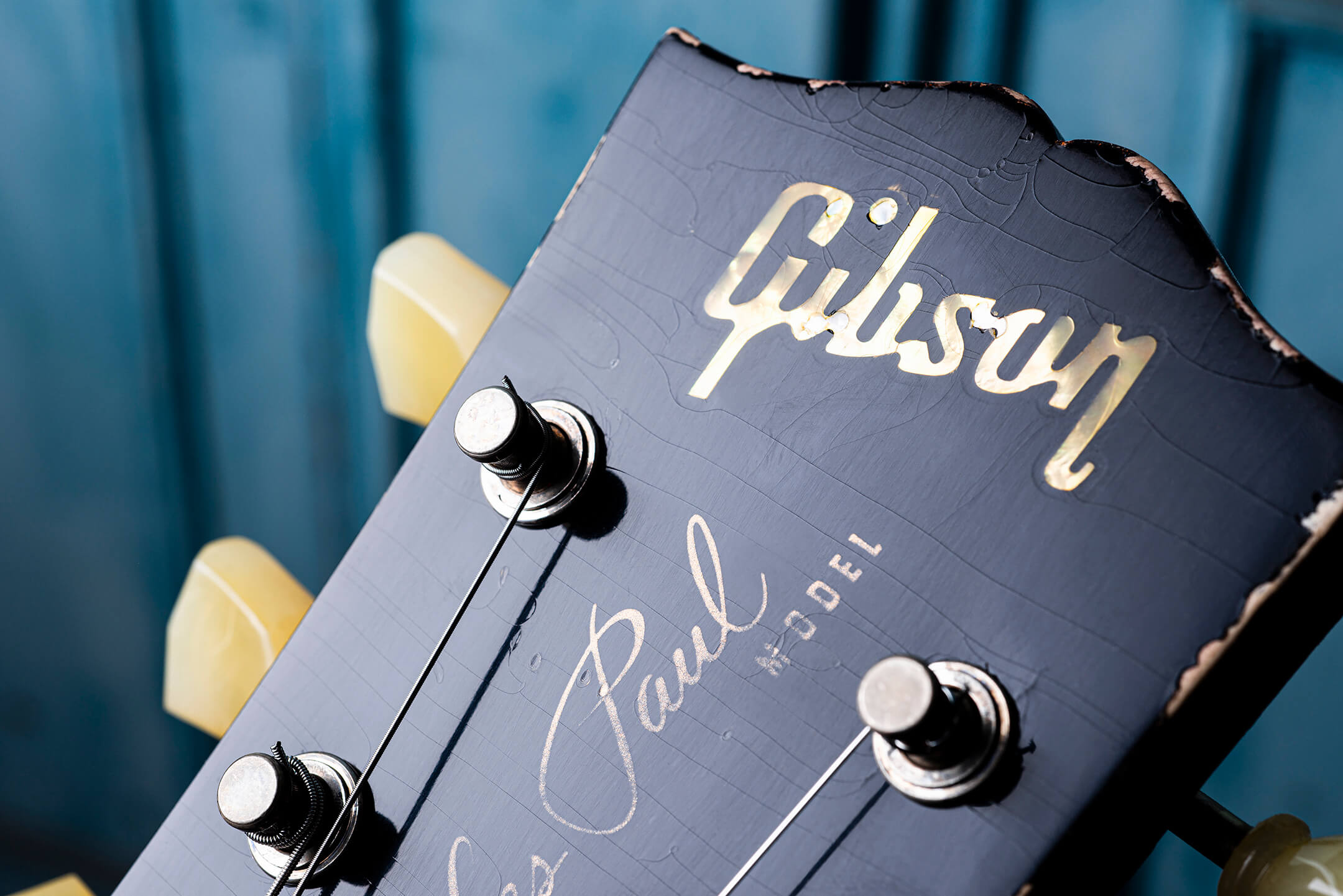
Hands on
Both of these guitars are on the lighter end of the vintage spectrum and the neck shapes are indistinguishable. Everybody feels different about necks but having played numerous 1950s Les Pauls, we feel that Gibson has settled on a perfect profile here. A soft-shouldered soft V transitions to a fuller roundness that never gets close to being unwieldy. It’s almost a fantasy 1950s neck profile and, in addition to being ideal for a ’59 reissue, we actually prefer it to many of the vintage necks we’ve grappled with.
The feel is slinky, perhaps thanks in part to the ‘rule of 18’ fret spacing. This old-school method of calculating the intervals results in a slightly shorter scale length and usually contributes to easy playing and a marginally rounder tone. Both these guitars sound full, deep and clear unplugged, and the natural sustain is unmistakeable.
There’s very little to choose between them but the Green Lemon Fade model’s clarity, string-to-string balance and woody midrange voicing just edges it. Guitars are made from natural materials so this variation is only to be expected, and it demonstrates that trying before buying is always preferable.
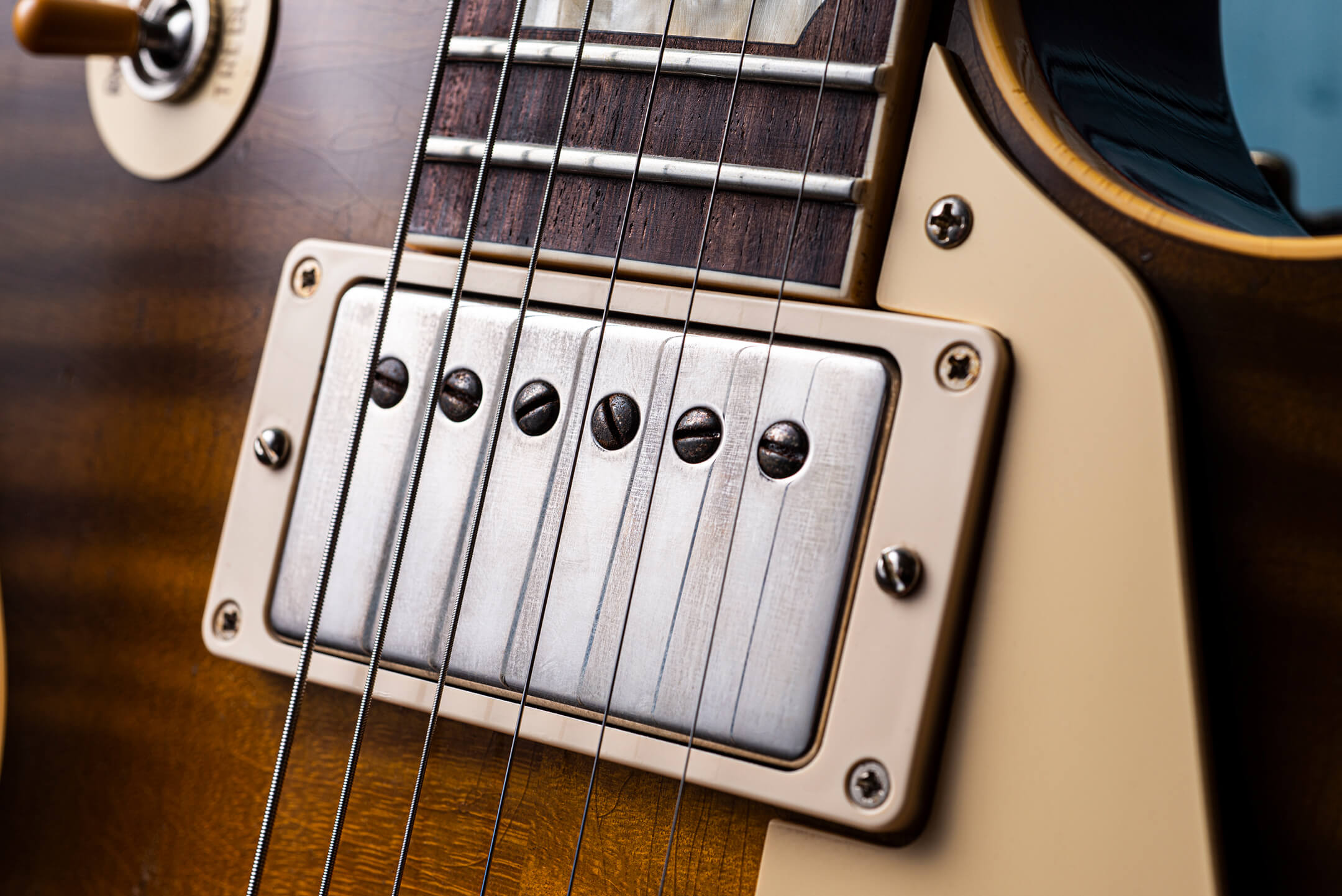
Testing the Murphy Lab models next to a 2016 Collector’s Choice and a genuine early 1960 Burst proves revealing. Firstly, the unpotted Custom Buckers in the Murphy Lab guitars are vastly superior to the Collector’s Choice model’s pickups, sounding clearer, far less harsh and closer in voicing to the vintage PAFs.
The vintage PAFs have a more 3D quality, extended upper harmonics and greater clarity, but the new Custom Buckers provide a very similar midrange voicing, with ample quack from the bridge and a fluty vocal quality from the neck. With the same amp settings, the modern pickups can seem a bit harsh and shouty next to the vintage units, but you can dial that out easily enough. We find the controls similar in response to the vintage ones and clarity is retained when you turn down the volume.
As for how the two Murphy Lab guitars compare? Well, the Light Aged model is a wonderful instrument but there’s something special about the Heavy Aged guitar’s ethereal sustain and tonal balance that makes it stand out. In fact, the Heavy Aged Green Lemon Fade model is, by some margin, the best looking, playing and sounding modern Les Paul we have ever played.
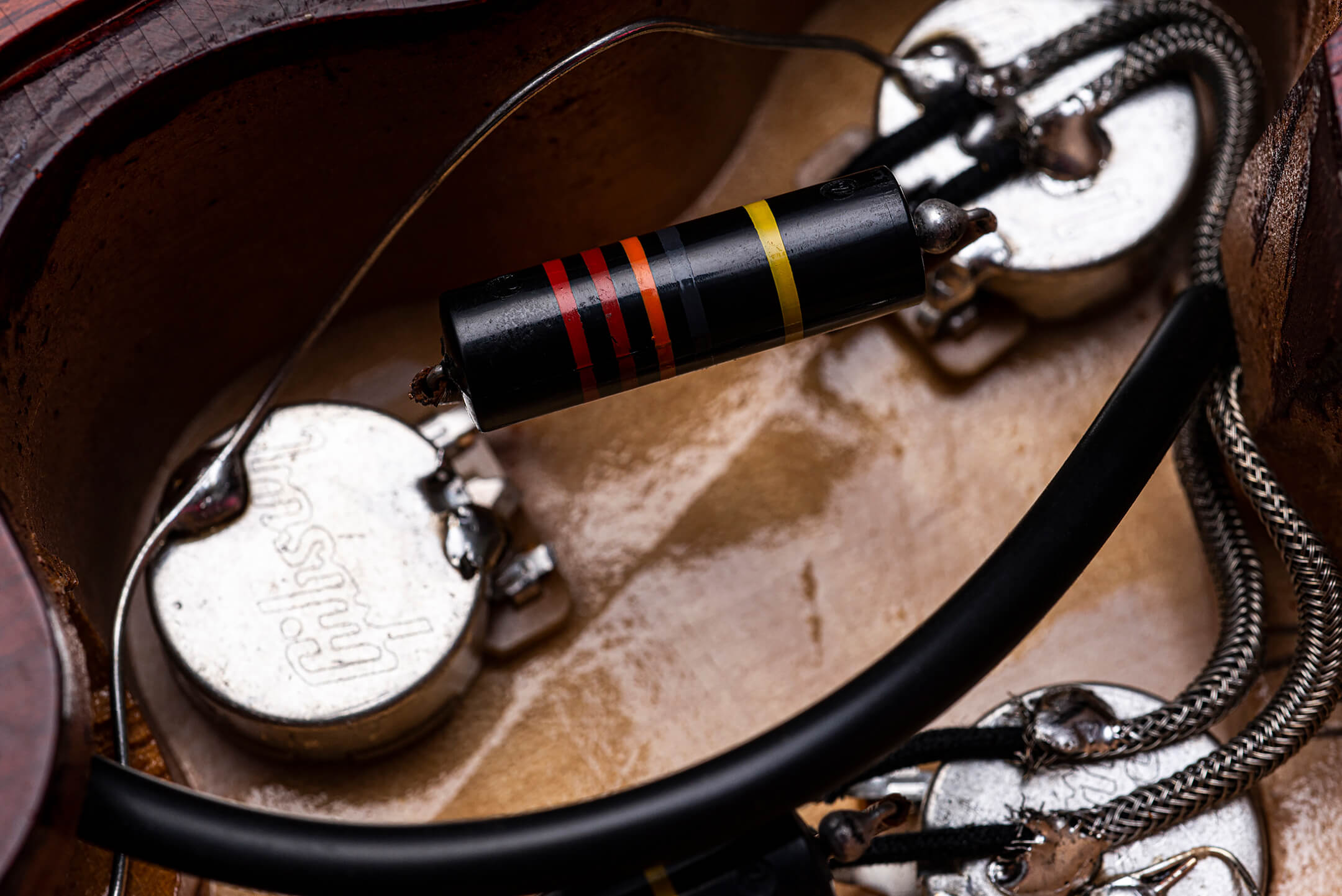
Having spent time with various Collector’s Choice Les Pauls, there’s much to like about them. But we always find the relic’ing unconvincing, the colours can seem a bit off and they never make you feel as if you’re playing a genuine vintage guitar. Furthermore, we don’t know of any serious player with a Collector’s Choice guitar who hasn’t swapped out the pickups – and many upgrade the hardware and controls too. Do the Murphy Lab models address these shortcomings?
Taking a cold hard look, as we’re obliged to, the answer is yes and no. The Murphy Lab has raised the bar considerably when it comes to lacquer ageing and the finishes are beautifully applied. With aspects like the binding scraping along the fretboard rollover and the jagged edges where the lacquer has been chipped off, the attention to detail is extremely impressive too.
In combination with the sublime neck profile and ideal weights of our guitars, it really is enough to make you feel like you are playing a 1950s classic. For a modern factory-built guitar, that’s a considerable achievement, but it’s still a work in progress.
There’s nothing remarkable about the hardware and, despite the ageing, the bridge saddle corners are still sharp enough to cut your hand. The zamak alloy ABR-1 bridges and tailpieces Gibson used during the Burst era had a big influence, so if you’re truly obsessive about vintage tone as well as looks, you’ll still have to source costly original parts or high-end repros. We also think the shiny switches are a disappointing oversight and the pristine plastics detract slightly from the Murphy Lab’s stellar work.
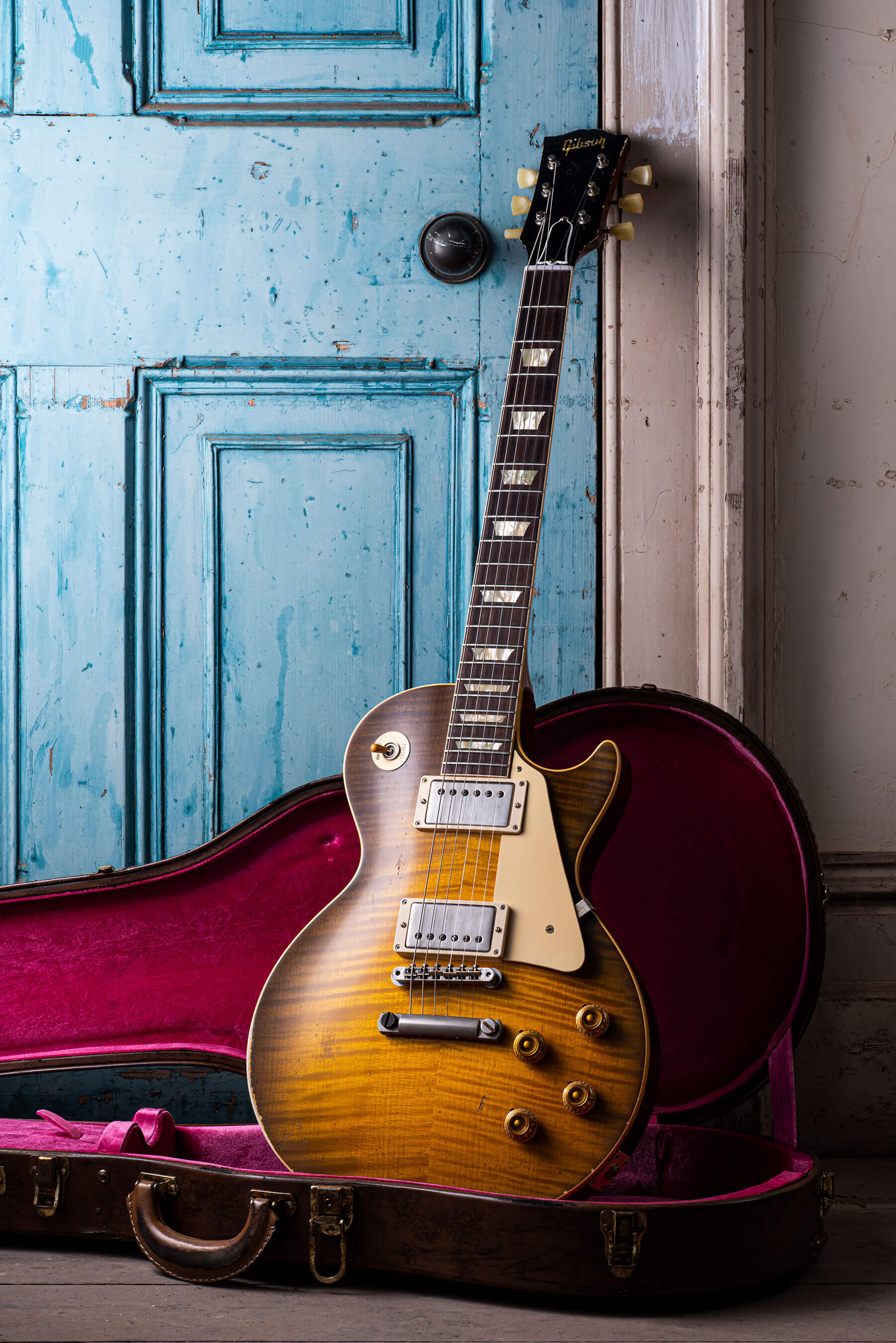
Pickup lines
With Brazilian rosewood off the table, the pachyderm in the parlour is always going to be the pickups. Granted, vintage Les Paul fans tend to obsess more than most over period details, but if you want your Les Paul to sound just like a vintage example, the pickups are by far the most important factor. We like the unpotted Custom Buckers and enjoy the tones they produce, but they don’t quite sound like authentic vintage PAFs – or indeed the best boutique replicas.
Given the high ticket prices of these guitars you might reasonably expect them to be fitted with the finest humbuckers known to humankind. We’ve always wanted to ask someone senior at Gibson if the company ever intends to make vintage-style PAFs again and, to his credit, Mat is remarkably forthcoming.
“We have the recipe book for PAFs and we’re keenly aware of what it takes, but when we put those components together along with the original magnet formula – which is unusual and not one that is frequently used – the resulting pickups didn’t sound like PAFs.
“Vintage PAFs are a lot darker and more midrange heavy than people think and if you loaded your guitar with a set of 1959 PAFs, most people probably wouldn’t prefer them. Gibson was sourcing Alnico IV in the late 1950s from a telephone company for humbuckers specifically, but we don’t know that much about the makeup of the magnets they got. For playing at home most people would prefer the sound of an alnico III pickup and not alnico IV.
“We should have owned the pickup market for Gibson-style pickups and we don’t. That’s an opportunity that we have been aware of all the time, but the time hasn’t been right. What I can say is that we are going to tell stories that have never been told, with never before seen blueprints and archives, and we will be making extremely historically accurate PAFs in the future.”
The darkness and midrange heaviness Mat describes are not characteristics we associate with the many original PAFs we have tried. But we’ll agree to differ and are excited by the prospect of Gibson finally getting around to making proper PAFs again.

Regarding pricing, as you might expect: the heavier the ageing, the higher the price. Despite what militant anti-relic’ers might think, ageing guitars to this standard demands a lot of time and considerable skill, and that inevitably adds to the unit price. With £900 separating our Light and Heavy Aged review models, that seems like a reasonable mark-up.
Ultra Light is the cheapest option (£6,099) and if you would prefer to write your own story onto a guitar, Gibson’s new lacquer formulation will allow you to do just that. But remember, all the Murphy Lab models will continue to age naturally.
Both of these guitars will live long in our memory and we can’t wait to see some of the other models that are getting the Murphy Lab treatment. Admittedly we have reservations about some of the parts, but if you’ve always dreamed of owning a vintage Les Paul replica that looks and feels like the real thing, the wait could be over.
Key Features
Gibson Murphy Lab 1959 Les Paul Standard Cherry Tea Burst Light Aged
- PRICE £6,999 (with Lifton reissue 5-latch case)
- DESCRIPTION Solidbody electric guitar, made in the USA
- BUILD Fijian mahogany body with bookmatched maple cap, Royalite body binding, set mahogany neck, bound Indian rosewood fretboard, celluloid nitrate inlays, 22 authentic medium-jumbo frets, nylon nut, vintage-correct plastics
- HARDWARE ABR-1 tune-o-matic bridge, aluminium stop tailpiece, Kluson single line/single ring tuners
- ELECTRONICS 2x Custom Bucker Alnico III unpotted pickups, vintage taper CTS volume and tone potentiometers, 3-way pickup selector, paper-in-oil bumblebee tone capacitors
- SCALE LENGTH 24.57”/624mm
- NECK WIDTH 42.8mm at nut, 51.9mm at 12th fret
- NECK DEPTH 22.3mm at first fret, 24.4mm at 12th fret
- STRING SPACING 35.9mm at nut, 51.6mm at bridge
- WEIGHT 8.2lb/3.7kg
- LEFT HANDERS No
- FINISH Light Aged Cherry Tea Burst nitrocellulose lacquer
Gibson Murphy Lab 1959 Les Paul Standard Green Lemon Fade Heavy Aged
- PRICE £7,899 (with aged Lifton reissue 5-latch case)
- DESCRIPTION Solidbody electric guitar, made in the USA
- BUILD Fijian mahogany body with bookmatched maple cap, Royalite body binding, set mahogany neck, bound Indian rosewood fretboard, celluloid nitrate inlays, 22 authentic medium-jumbo frets, nylon nut, vintage-correct plastics
- HARDWARE ABR-1 tune-o-matic bridge, aluminium stop tailpiece, Kluson single line/single ring tuners
- ELECTRONICS 2x Custom Bucker Alnico III unpotted pickups, vintage taper CTS volume and tone potentiometers, 3-way pickup selector, paper-in-oil bumblebee tone capacitors
- SCALE LENGTH 24.57”/624mm
- NECK WIDTH 42.9mm at nut, 52.1mm at 12th fret
- NECK DEPTH 22mm at first fret, 24.4mm at 12th fret
- STRING SPACING 35.7mm at nut, 50.3mm at bridge
- WEIGHT 8.4lb/3.8kg
- LEFT HANDERS No
- FINISH Heavy Aged Green Lemon Fade nitrocellulose lacquer
- CONTACT Gibson.com
Like this? Try these
- Eastman SB59/v £2,099
- Rock N Roll Relics Heartbreaker £4,295
- Heritage Custom Core Collection H-150 Artisan Aged £4,299



